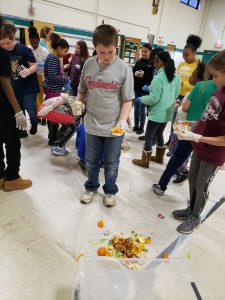This post was written by Amanda Price and originally appeared on ISTC’s Green Lunchroom Challenge microsite, which features archived resources from a past project focused on food waste prevention and reduction in K-12 schools, as well as periodic posts related to food waste issues and resources for food waste reduction in other sectors, such as health care.
We’re grateful to Amanda for sharing her experiences teaching the new food waste curriculum to Illinois students and thrilled to hear about students inspired to take action. All photos are courtesy of Amanda Price.
The Illinois Environmental Protection Agency (EPA) partnered with the University of Illinois at Urbana-Champaign Office for Mathematics, Science, and Technology Education (MSTE) to create a two-week food waste curriculum unit for fifth and sixth grade educators. The unit is aligned to Next Generation Science Standards (NGSS) and will be free and available online at the end of May 2020. It will be housed with the first unit created by MSTE and Illinois EPA on surface water and algae on the Environmental Pathways website.
 Amanda Price piloted the unit in two fifth grade science classes at Butler Elementary and Sandburg Elementary February-March 2020. Both schools are located in Springfield, IL. Amanda works as a Graduate Public Service Intern (GPSI) in the offices of Environmental Education and Community Relations at Illinois EPA. The GPSI program places University of Illinois Springfield (UIS) graduate students in state agency internships in for the duration of their studies. Amanda will earn a master’s degree in Environmental Sciences this May 2020. She taught the unit as part of her capstone graduate project.
Amanda Price piloted the unit in two fifth grade science classes at Butler Elementary and Sandburg Elementary February-March 2020. Both schools are located in Springfield, IL. Amanda works as a Graduate Public Service Intern (GPSI) in the offices of Environmental Education and Community Relations at Illinois EPA. The GPSI program places University of Illinois Springfield (UIS) graduate students in state agency internships in for the duration of their studies. Amanda will earn a master’s degree in Environmental Sciences this May 2020. She taught the unit as part of her capstone graduate project.
The food waste unit follows the NGSS investigative storyline model that is  driven by student questions. It teaches students the importance of food waste reduction, landfill diversion, and composting as part of a circular food system. Students create “landfills in a jar” with materials given to them with the goal of protecting the sand, or “groundwater,” at the bottom of the jar. Students also create “compost in a jar” using fresh food scraps and other compostable materials. Students monitor their jars throughout the unit and record scientific data such as temperature and mass. They learn how bacteria act as decomposers. The unit also incorporates map-reading and asks students to think critically about the pros and cons of choosing space for new landfill construction.
driven by student questions. It teaches students the importance of food waste reduction, landfill diversion, and composting as part of a circular food system. Students create “landfills in a jar” with materials given to them with the goal of protecting the sand, or “groundwater,” at the bottom of the jar. Students also create “compost in a jar” using fresh food scraps and other compostable materials. Students monitor their jars throughout the unit and record scientific data such as temperature and mass. They learn how bacteria act as decomposers. The unit also incorporates map-reading and asks students to think critically about the pros and cons of choosing space for new landfill construction.
 The main hands-on activity in the unit is a food waste audit, which can be performed at various scales. Students use data from the audit to calculate the estimated food wasted per person, during the school year, etc. Students end the unit by creating a community awareness or action plan to inform their community or advocate for change. A few students at Butler Elementary wrote a letter to the principal asking him to install a clock in the cafeteria so students could track how much time they had to eat. The principal took swift action and ordered the clock.
The main hands-on activity in the unit is a food waste audit, which can be performed at various scales. Students use data from the audit to calculate the estimated food wasted per person, during the school year, etc. Students end the unit by creating a community awareness or action plan to inform their community or advocate for change. A few students at Butler Elementary wrote a letter to the principal asking him to install a clock in the cafeteria so students could track how much time they had to eat. The principal took swift action and ordered the clock.
Illinois EPA looks forward to sharing the free curriculum with both formal and informal educators around the state. The unit helps increase students’ environmental awareness and stewardship and is best paired with action to reduce waste in the school.



